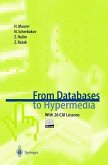This book not only equips you to design multimedia delivery systems, but also gives you a feel for what multimedia computers could be doing in 3 or 5 years time.
Tim Morris introduces the reader to the methods of generating and delivering multimedia, and also gives an overview of current research in the area in order to show the generic tasks multimedia systems will be achieving in the future. The book is divided into 2 parts, discussing how multimedia delivery systems are designed and constructed, and then covering the methods of realising true multimedia computing.
Although Multimedia Systems is written to be read alongside a multimedia module of a computer science undergraduate course, it will be of general interest to all those working in multimedia.
Supplementary material is provided via the WWW including a summary and source material for project work. http://www.co.umist.ac.uk/~dtm/software.html.
What are Multimedia Systems? This book is intended to expose you to multimedia in its widest sense. The popular understanding of this subject is that it is the integration and delivery of text, images and sound, usually on a desktop Pc. We are all familiar with examples from the extensive range of multimedia titles available on CD-ROM. These give us a rich set of sensory experiences, and, perhaps more important, we are free to navigate our way through the information as we choose. However, this is only half of the story since these titles can only deliver information. A recent IEEE publication (Chen, 1997) suggested that multimedia should include all systems that integrate diverse media, in standalone or networked applications, either for presentation or communication. Diverse media implies visual and aural information (text, static and moving pictures and sound). Networking could be realised using intranet or telephone links. Presentation systems would imply the multimedia delivery systems with which we are all familiar. Communication implies a two-way interaction with the computer. So as well as transmitting infor mation, multimedia systems should also be able to understand and react to information presented to them using the same set of diverse media (such as typed text, pictures and sound).
Tim Morris introduces the reader to the methods of generating and delivering multimedia, and also gives an overview of current research in the area in order to show the generic tasks multimedia systems will be achieving in the future. The book is divided into 2 parts, discussing how multimedia delivery systems are designed and constructed, and then covering the methods of realising true multimedia computing.
Although Multimedia Systems is written to be read alongside a multimedia module of a computer science undergraduate course, it will be of general interest to all those working in multimedia.
Supplementary material is provided via the WWW including a summary and source material for project work. http://www.co.umist.ac.uk/~dtm/software.html.
What are Multimedia Systems? This book is intended to expose you to multimedia in its widest sense. The popular understanding of this subject is that it is the integration and delivery of text, images and sound, usually on a desktop Pc. We are all familiar with examples from the extensive range of multimedia titles available on CD-ROM. These give us a rich set of sensory experiences, and, perhaps more important, we are free to navigate our way through the information as we choose. However, this is only half of the story since these titles can only deliver information. A recent IEEE publication (Chen, 1997) suggested that multimedia should include all systems that integrate diverse media, in standalone or networked applications, either for presentation or communication. Diverse media implies visual and aural information (text, static and moving pictures and sound). Networking could be realised using intranet or telephone links. Presentation systems would imply the multimedia delivery systems with which we are all familiar. Communication implies a two-way interaction with the computer. So as well as transmitting infor mation, multimedia systems should also be able to understand and react to information presented to them using the same set of diverse media (such as typed text, pictures and sound).








